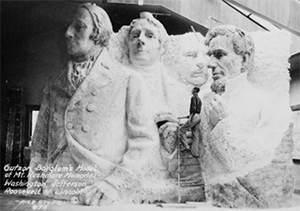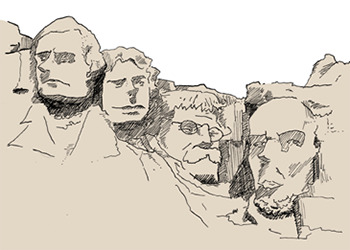InTrans / Jun 15, 2015
Why should I care: Mount Rushmore without a designer?
Go! Magazine
 posted on June 15, 2015
posted on June 15, 2015
In this series, we are taking a look at some of the most well-known landmarks in the world. But, “what would these famous landmarks look like without expert designers, engineers, or construction managers?” Many of these professionals must work together on this type of large-scale project (i.e., building a landmark that can stand the test of time). In this article, we will explore what a famous landmark in South Dakota—Mount Rushmore—would look like without a designer.
Did you know?
Did you know that Mount Rushmore is made of granite? Granite is a very hard rock. It is made up of quartz and feldspar, which are formed together when liquid rock from the Earth’s crust is pushed to the surface. So how do you even cut granite, let alone sculpt it into Mount Rushmore? Dynamite! Over 90 percent of Mount Rushmore was formed by using dynamite, leaving only three to five inches of granite for the sculptors to carve into. By the end, nearly 800 million pounds of rock was removed! 1
History
The Mount Rushmore monument itself covers over two square miles. Starting in 1927 and ending in 1941, the entire process of building Mount Rushmore took 14 years. The project cost just under one million dollars to complete and included over 400 workers—with titles such as “call boys” (who moved workers vertically on the harnesses), “powdermen” (who placed dynamite), drillers, blacksmiths, and even housekeepers. The impetus for this monument was for tourism and to celebrate four presidents (George Washington, Thomas Jefferson, Theodore Roosevelt, and Abraham Lincoln), and their involvement in protecting American freedom and democracy—a worthy cause!

The designer, Gutzon Borglum, helped see the project through to the end. Following Borglum’s hiring, he visited the site originally intended for Rushmore: Needles, South Dakota. Borglum thought Needles was not an ideal location due to the fact it consisted of thin granite pillars, and instead proposed that the location be changed to Mount Rushmore because of the better granite composition and its southeast orientation, which allowed for better sun exposure.
How did Borglum help design and build Mount Rushmore?
Borglum created a model of Mount Rushmore, which the designers measured and multiplied in order to scale it up. The sculptors took thousands of measurements and then multiplied those all by 12. To carve into the mountain, workers used chisels and jackhammers, which sometimes weighed half as much as the workers! They then used red paint to mark certain facial features and how deep the carving needed to be and such. The carvers needed both artistic and engineering skills—like using physics to understand that by drilling closely aligned holes in the granite (called “honeycombing”), that the rock could then be removed by hand.
Borglum was known to look at Rushmore from all angles and at every hour of the day, just to look for things to fix. The original plan was to also carve the upper bodies of the presidents, but federal funding was not sufficient, so the project ended with just the four presidents’ faces.
What was it like to be a sculptor on Mount Rushmore?
Well for starters, their job entailed being suspended over the edge of the cliff in a steel leather harness. Hopefully these sculptors weren’t scared of heights! At any given time, a worker was hanging 60 feet above ground—the same height as a six story building! And just to give you an idea of how large the presidents’ faces really are, the average nose size is twenty feet long; now that’s a big nose!
The construction of Mount Rushmore was done during the Great Depression, which meant there were many eager workers ready to be employed. Borglum was known to be quite strict and fired workers he felt weren’t fit for the job. One worker, Jack Payne, was fired just for yodeling! 2
What if there weren’t designers?
Much of the credit for Mount Rushmore is due to Borglum for his original model. But what if Borglum, or any other designer, was never hired? What would Mount Rushmore look like? Honestly, it probably wouldn’t exist at all! Today, without a designer with a know-how of engineering and construction, there might just be holes in the mountainside.
Or, as Stephen Post, a modern-day graphic designer speculates, it might just be “bad engineering.” In the hands of a non-designer, or even worse a designer without the artistic skills, our age-old presidents may have looked a bit cross-eyed.

When it comes down to it, Mount Rushmore was the byproduct of many peoples’ hard work and skills. The monument’s success is illustrated by the fact that it attracted over two million people just in 2012. Mount Rushmore is located in the Black Hills of South Dakota, and is within 15 miles of Custer State Park and the Crazy Horse monument. On the way, visitors are able to get a closer look at the presidents by taking the Presidential Trail, which goes in a half mile circle around the monument.
Why are designers needed?
Designers work with engineers and many others to take what is called as a “holistic approach.” In other words, it’s not all about the aesthetics. Although “looks” are important, structural soundness and functionality are just as critical. For instance, if the presidents were too big and protruded too far from the cliff, then it is likely the whole thing could have fallen apart decades ago!
Citations
- http://www.smithsonianmag.com/history/the-making-of-mount-rushmore-121886182/?no-ist
- http://www.jeanpatrick.com/mount-rushmore.html
By Jackie Nester, Go! Staff Writer